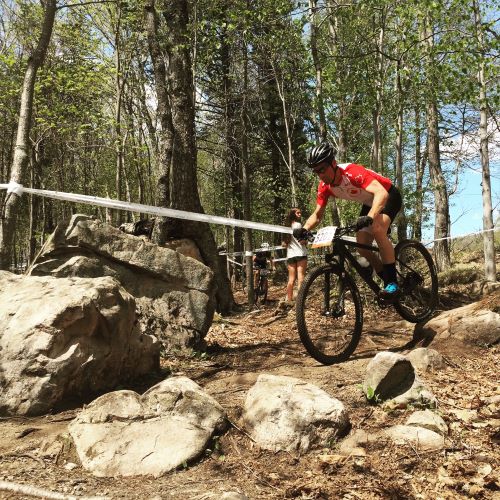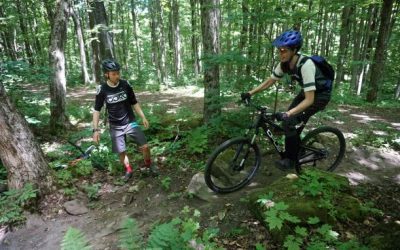Often I catch myself talking to Coaching Clients about race results (or goal events) for extended periods, long calls or back-and-forth emails. It is tough not to since races are fun, exciting and ultimately why we train for months on end! It is fantastic to share so many of these post-race conversations with clients and to find out more about what went well and what we can improve on in our next block of training. But I (try to) constantly remind myself that the key to success lies in the day-to-day grind. We must not lose sight of our daily focus and next steps. We need to make sure that you prepare so well that race day is simply about pedaling and doing what you practiced.
There is no magic on race day, only the execution of what you have practiced in the day to day grind. If you are prepared to be in the fire, you will thrive.
Sport is about becoming good at being uncomfortable. In mountain biking, this is steering around trees while you are cross-eyed and breathing really hard. This high-intensity race pace is like a contest of keeping your hands in a fire. Some people will stay far away from the fire, some will go in too deep and get burned and some will find that optimal zone where they can be uncomfortable but hold on and, over time, get very good at staying in that fire and pushing their limits. This is a mental skill as much as it is a result of physical training. Our fitness will come and go but that ability to work hard and coordinate our cycling is definitely a skill trained over time. The catch is you have to be recovered, motivated. and focused enough to train ‘in the fire’.
Train Harder, Train Easier
Athletes who are new to sport, or struggling to meet their goals, will generally be very good at starting and being near the front at the start of the race but also consequently end up falling back and ending up with poor results (Scenario A) or athletes will be poor starters who struggle to really push themselves into the ‘fire’ (Scenario B).

The fast starters are often those who played team sports previously. They love intensity and competition, they had anything steady. They are usually well served to work on muscular endurance and spending MORE time at a hard effort and developing a feel for different levels of intensity so they can adjust workloads and pace as required for their event. These athletes often will not have the endurance rides or full sets of workouts. They will do 1 x 10-minute effort (maybe a ‘Strava segment’) or just a 3 x 10 that they did a really hard effort to start and then decided that was enough for the day (ie. this is the same as they race … hard start, failed rest of race).
The goal for these athletes is to FINISH a well-paced set of intervals. 2 x 20 or 3 x 10 min threshold workouts would be an example. Since these athletes will really not enjoy long efforts and long rides there will be a need for some group rides, some point-to-point rides, some use of endurance races or stage races to build a base. Intervals such as 30/30s may help build sustainable power with a more tolerable on/off rhythm.
Endurance is done 3-4x a week and around the intervals at 65-75%, watching for these athletes to dip under and over the range rather than riding steadily in the endurance range.

The other type of athlete is the ‘endurance athlete’ who rides a lot but struggles with the ‘defining moments’ in the race. The start, the accelerations, the attacks, the hills. You can finish the race, so more endurance is not the issue. I feel for these athletes as this is me. Tired, mentally can tough through any distance but to survive the first 10 seconds of the race is SO HARD. These athletes may need to pay attention to going easy enough in endurance rides (or do fewer endurance rides, at least for some portions of the year) to allow for hard enough intensity to practice being in the ‘fire’.
I have had several endurance athletes (myself included) take a lot of recoveries, add in more strength training, do more walking (forced LOW intensity and mobility and stress reduction) And then put all their cycling energy into 2-3 REALLY focused efforts a week. It can be magical how recovery and motivation make for great results. Less is more for these athletes a few 10-second sprints (even start sims) or short Vo2/Hill reps starting at the low end of the rep. range (ie. 3 x 2-3min)
Keep Your Hands in the Fire
The 2 weekly intensity workouts should have the process goal (based on feeling, not wattage) to KEEP YOUR HANDS IN FIRE. The fast starter needs to keep them longer and perhaps not go quite as deep (or as far into it) and the endurance athlete needs to PUSH harder and get into the ‘fire’ early and then fight the urge to back off. I really like testing and TTs to encourage this playful relationship to spending time with discomfort, becoming comfortable with being uncomfortable.
This is a lifelong journey to Endure (have you read or listened to our podcast with Alex Hutchinson yet??)






